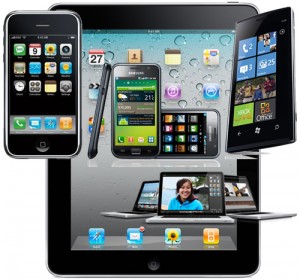This year, the Learning at Work Day theme is ‘Learning for Growth’. The constant availability of mobile learning already makes it ideal for self-development, but are you making the most of this medium?
A mobile learning course isn’t an e-learning course resized to fit on a smartphone. Or at least it shouldn’t be. It’s very easy, when designing a course, to forget that something that works fantastically on a desktop computer may not be so impressive when squashed onto a much smaller screen.
So when we’re asked to produce a mobile learning course, our aim should be to develop considered, dedicated mobile learning, rather than developing e-learning that can also run on mobile devices. Mobile learning has different possibilities to e-learning, and we should make the most of these.
It helps to start with the basics. Why does the client want the course to be accessed from mobile devices? Sometimes there is a practical reason; a hospital’s employees may spend more time on-site than in an office and will have easier access to a mobile phone or tablet than a computer. Maybe the idea is to encourage people to dip in and out of the learning, which is easier when it can be accessed at any time through something you carry around with you.
Once you have your client’s purpose in mind, you can start crafting your content to fit it. There are a few key areas that you can focus on to make the most of your mobile learning, which we’ll take a look at now:
1. Devise for the device
This is the big one. These days we expect that online courses will have interactive screens – forty pages of text won’t impress anyone, and more importantly, probably won’t teach them much either. But before you start scripting intricate puzzles and flashy animations, think about the capabilities of the device itself – some don’t use sideways scrolling, for example, and not all devices support Flash (Adobe has discontinued Flash for mobile devices, so if your course is going to be used in the long term, then you shouldn’t really be using it at all!).

This is the main reason why, if possible, it is far better to design a course for one specific device, rather than several. It means that you can design your interactions to use the full potential of that device, rather than having to go for the lowest common denominator.
2. Keep it simple, keep it smart.
Mobile devices can be anything from a laptop with the same screen size as a desktop computer to a mobile phone, and all of them need to be considered differently. The small screen size on a mobile phone means that a design with lots of colours and images will become confused, so it’s better to stick to a clean layout and simple colour scheme. Additionally, mobile learning is often used in places that are full of distractions, such as train carriages or on a lunch break – a course that is easy to follow is more likely to hold a learner’s attention than one that is over-crowded. Graphic novel styles often work well for mobile learning, as they have a limited amount of text on screen and use a simple but engaging layout.

It’s worth giving some thought to navigation too. The iPhone uses ‘swipe’ gestures to move through screens – incorporating this into your course will make the environment feel more intuitive, and can allow your learner to interact with the content in new ways. I’ve worked on an interaction that had the learner ‘piloting’ a plane, which they had to direct through the correct answer ‘hoops’ in response to questions. Using the iPhone’s touchscreen to direct the plane instead of clicking on the hoops would make this more game-like, and make better use of the device’s capabilities.
3. Recognise that if it’s immediate, it should be revisitable.
The key benefit of mobile learning is that it can be carried around in your pocket, so it would be useful to have a course that could be used as a reference tool as well as instructions. On a building site and can’t remember which type of wire cutter you need? Open up your training course and go straight to the tools guide. Or why not promote message boards as a way for learners to ask questions and get quick answers?
Think about what makes mobile learning different, and use that to create exciting courses.
And finally, I’ll leave you with a comic (courtesy of Stephen Collins Illustration) on just how mobile devices put instant knowledge at our fingertips …
http://www.stephencollinsillustration.com/gallery/a_apps.jpg




